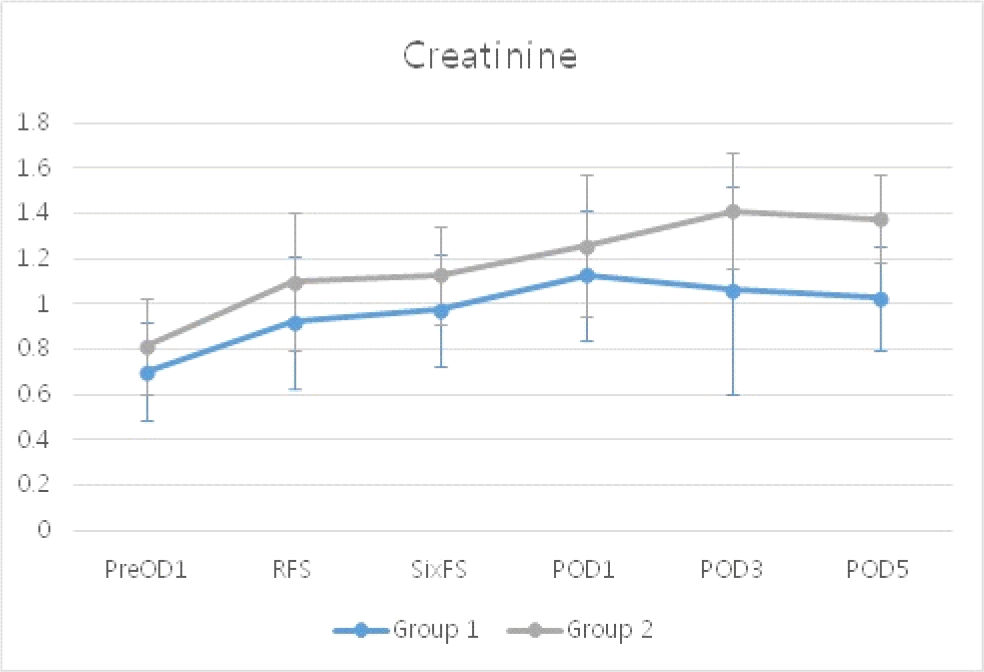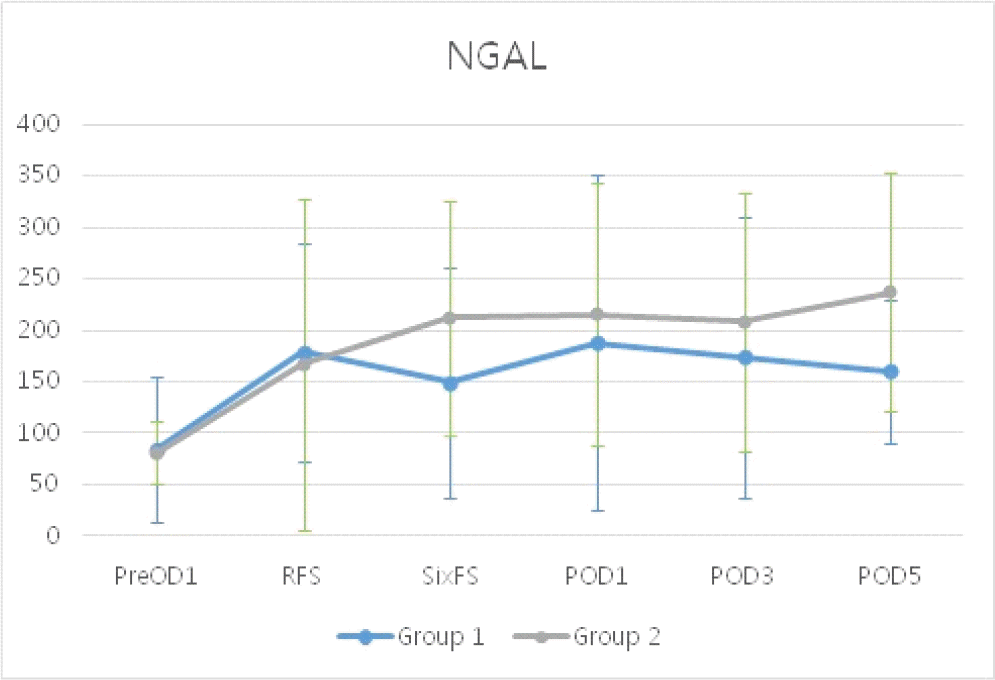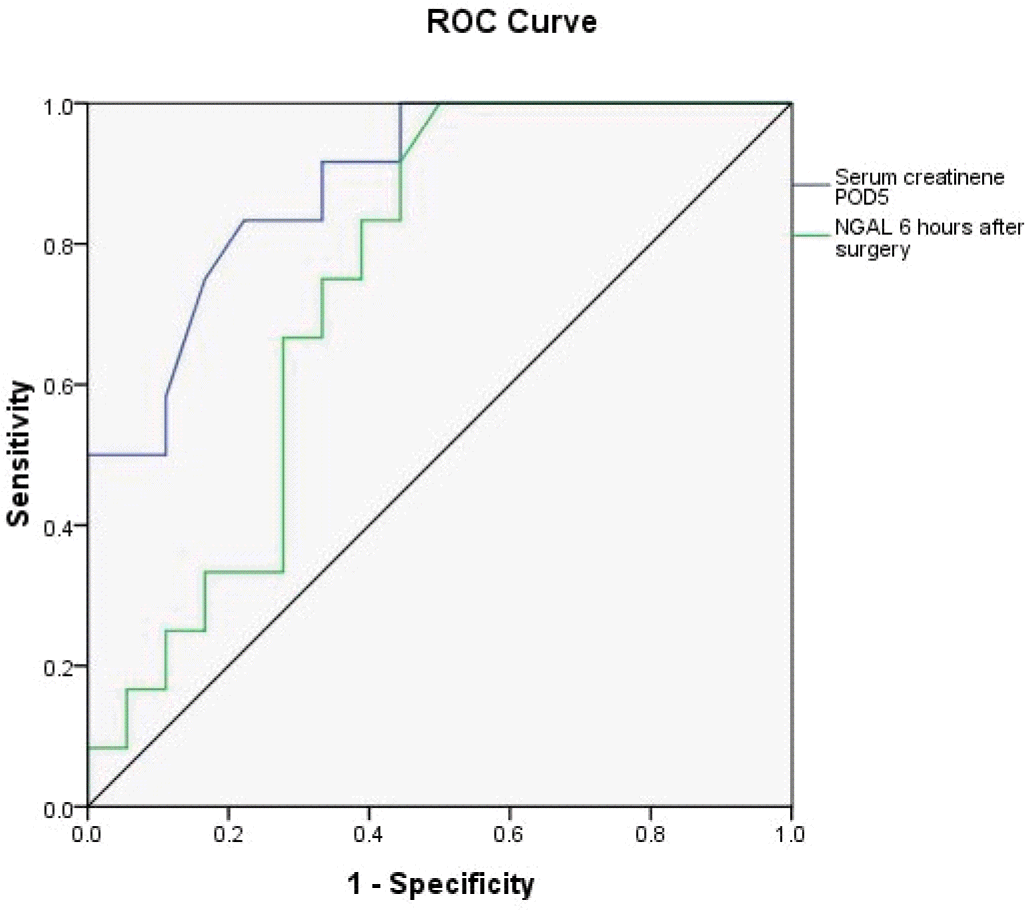Abstract
Objectives
The standard metrics used to monitor the progression of acute kidney injury (AKI) include markers such as serum creatinine, blood urea nitrogen, and estimated glomerular filtration rate (eGFR). Moreover, neutrophil gelatinase-associated lipocalin (NGAL) expression has been reported to modulate oxidative stress.
Methods
We aimed to evaluate the usefulness of serum NGAL levels for monitoring renal function after radical nephrectomy (RN). We prospectively collected data from 30 patients who underwent RN. We analyzed serum NGAL and creatinine at 6 time points: preoperative day 1, right after surgery, 6 hours after surgery, postoperative day (POD) 1, POD 3, and POD 5. We compared these measurements according to the eGFR values (classified as chronic kidney disease stage III; CKD III or not) using data obtained 3 months after surgery.
Results
The mean age was 65.5 years (range, 45–77 years), and the male-to-female ratio was 2:1. At the last follow-up examination, there were 12 patients (40%) with CKD III. Using receiver operating characteristic analysis, we found that serum creatinine on POD 5 (area under the curve [AUC], 0.887; P = 0.000) and NGAL at 6 hours after LRN (AUC, 0.743, P = 0.026) were significant predictors of CKD III. The development of CKD III after LRN was associated with the serum creatinine level on POD 5 and the NGAL at 6 hours after surgery.
Go to : 
REFERENCES
1.Kang SH., Rhew HY., Kim TS. Changes in renal function after laparoscopic partial nephrectomy: comparison with laparoscopic radical nephrectomy. Korean J Urol. 2013. 54:22–5.

2.Zorn KC., Gong EM., Orvieto MA., Gofrit ON., Mikhail AA., Msezane LP, et al. Comparison of laparoscopic radical and partial nephrectomy: effects on long-term serum creatinine. Urology. 2007. 69:1035–40.

3.Li L., Lau WL., Rhee CM., Harley K., Kovesdy CP., Sim JJ, et al. Risk of chronic kidney disease after cancer nephrectomy. Nat Rev Nephrol. 2014. 10:135–45.

4.Chung JS., Son NH., Byun SS., Lee SE., Hong SK., Jeong CW, et al. Trends in renal function after radical nephrectomy: a multicentre analysis. BJU Int. 2014. 113:408–15.

5.Vats HS., Rayhill SC., Thomas CP. Early post-nephrectomy donor renal function: laparo-scopic versus open procedure. Transplantation. 2005. 15:79:. 609–12.

6.Koyner JL., Bennett MR., Worcester EM., Ma Q., Raman J., Jeevanandam V, et al. Urinary cystatin C as an early biomarker of acute kidney injury following adult cardiothoracic surgery. Kidney Int. 2008. 74:1059–69.

7.Mishra J., Dent C., Tarabishi R., Mitsnefes MM., Ma Q., Kelly C, et al. Neutrophil gelati-naseassociated lipocalin (NGAL) as a bio-marker for acute renal injury after cardiac surgery. Lancet. 2005. 365:1231–8.

8.Bachorzewska-Gajewska H., Malyszko J., Sitniewska E., Malyszko JS., Dobrzycki S. Neutrophil-gelatinase-associated lipocalin and renal function after percutaneous coronary interventions. Am J Nephrol. 2006. 26:287–92.

9.Shemin D., Dworkin LD. Neutrophil gelatinase-associated lipocalin (NGAL) as a bio-marker for early acute kidney injury. Crit Care Clin. 2011. 27:379–89.

10.Cai L., Rubin J., Han W., Venge P., Xu S. The origin of multiple molecular forms in urine of HNL/NGAL. Clin J Am Soc Nephrol. 2010. 5:2229 –35.

11.Helanova K., Spinar J., Parenica J. Diagnostic and prognostic utility of neutrophil gelatinase-associated lipocalin (NGAL) in patients with cardiovascular diseases—review. Kidney Blood Press Res. 2014. 39:623–9.
12.Bellomo R., Ronco C., Kellum JA., Mehta RL., Palevsky P. Acute Dialysis Quality Initiative workgroup. Acute renal failure - definition, outcome measures, animal models, fluid therapy and information technology needs: the Second International Consensus Conference of the Acute Dialysis Quality Initiative (ADQI) Group. Crit Care. 2004. 8:R204–12.
13.Bagshaw SM., George C., Bellomo R. ANZICS Database Management Committe. A comparison of the RIFLE and AKIN criteria for acute kidney injury in critically ill patients. Nephrol Dial Transplant. 2008. 23:1569–74.

14.Joannidis M., Metnitz B., Bauer P., Schusterschitz N., Moreno R., Druml W, et al. Acute kidney injury in critically ill patients classified by AKIN versus RIFLE using the SAPS 3 database. Intensive Care Med. 2009. 35:1692–702.

15.Sprenkle PC., Wren J., Maschino AC., Feifer A., Power N., Ghoneim T, et al. Urine neutrophil gelatinase-associated lipocalin as a marker of acute kidney injury after kidney surgery. J Urol. 2013. 190:159–64.

16.Koo KC., Hong JH., Lee HS., Jeh SU., Choi YD., Rha KH, et al. Accuracy of Urinary Neutrophil Gelatinase-Associated Lipocalin in Quantifying Acute Kidney Injury after Partial Nephrectomy in Patients with Normal Contralateral Kidney. PLoS One. 2015. 10:e0133675.

17.Shikanov S., Lifshitz D., Chan AA., Okhunov Z., Ordonez MA., Wheat JC, et al. Impact of ischemia on renal function after laparoscopic partial nephrectomy: a multicenter study. J Urol. 2010. 183:1714–8.

18.Thompson RH., Lane BR., Lohse CM., Leibovich BC., Fergany A., Frank I, et al. Renal function after partial nephrectomy: effect of warm ischemia relative to quantity and quality of preserved kidney. Urology. 2012. 79:356–60.

19.Song C., Bang JK., Park HK., Ahn H. Factors influencing renal function reduction after par-tial nephrectomy. J Urol. 2009. 181:48–53.

20.Choi JD., Park JW., Lee SY., Jeong BC., Jeon SS., Lee HM, et al. Does prolonged warm ischemia after partial nephrectomy under pneumoperitoneum cause irreversible damage to the affected kidney? J Urol. 2012. 187:802–6.

21.Funahashi Y., Hattori R., Yamamoto T., Sassa N., Fujita T., Gotoh M. Effect of warm ischemia on renal function during partial nephrectomy: assessment with new 99mTcmercaptoacetyltriglycine scintigraphy parameter. Urology. 2012. 79:160–4.

22.Firu SG., Streba CT., Firu D., Tache DE., Rogoveanu I. Neutrophil Gelatinase Associated Lipocalin (NGAL) - a biomarker of renal dysfunction in patients with liver cirrhosis: Do we have enough proof? J Med Life. 2015. 8:15–20.
23.Wasung ME., Chawla LS., Madero M. Biomarkers of renal function, which and when? Clin Chim Acta. 2015. 438:350–7.

24.Colombo JR Jr., Haber GP., Jelovsek JE., Lane B., Novick AC., Gill IS. Seven years after laparoscopic radical nephrectomy: oncologic and renal functional outcomes. Urology. 2008. 71:1149–54.

Go to : 
 | Fig. 1.Serum creatinine levels in CKD III and non-CKD III groups. Patients were grouped into 2 groups according to the eGFR values; the patients with eGFR equal to or higher than 60 mL/min/1.73 m2 were grouped into group 1 and those with eGFR lower than 60 mL/min/1.73 m2 were grouped into group 2, respectively. Abbreviations: PreOD, preoperative day; RFS, right after surgery; SixFS, 6 hours after surgery, POD, postoperative. |
 | Fig. 2.NGAL levels in CKD III and non-CKD III groups. Patients were grouped into 2 groups according to the eGFR values; the patients with eGFR equal to or higher than 60 mL/min/1.73 m2 were grouped into group 1 and those with eGFR lower than 60 mL/min/1.73 m2 were grouped into group 2, respectively. Abbreviations: PreOD, preoperative day; RFS, right after surgery; SixFS, 6 hours after surgery, POD, postoperative day. |
 | Fig. 3.Receiver operating characteristic analysis of serum creatinine and NGAL. Abbreviations: POD, postoperative day. |
Table 1.
Paired sample correlations between serum creatinine and NGAL
| Time point | N | Pearson correlation | P |
|---|---|---|---|
| PreOD1 | 30 | -0.019 | 0.919 |
| RFS | 30 | -0.246 | 0.191 |
| SixFS | 30 | -0.004 | 0.982 |
| POD1 | 30 | 0.082 | 0.668 |
| POD3 | 30 | 0.018 | 0.924 |
| POD5 | 30 | 0.170 | 0.370 |
Table 2.
Area under the curve of serum creatinine and NGAL in ROC statistics
Table 3.
Paired sample correlations between serum creatinine and eGFR and between serum NGAL and eGFR




 PDF
PDF ePub
ePub Citation
Citation Print
Print


 XML Download
XML Download